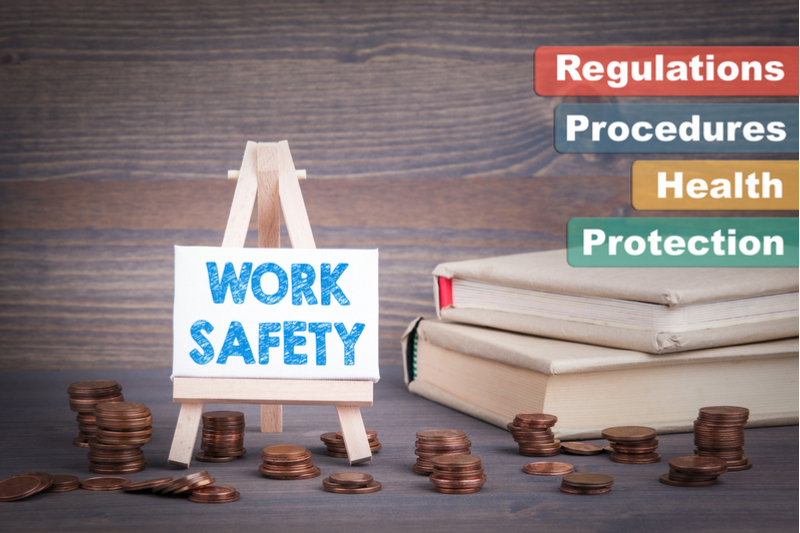Be informed, be safe: health and safety updates to be aware of
Health and safety regulations for businesses are constantly evolving to keep up to date with the needs of a modern workforce, and every employer needs to be aware of such changes to ensure they’re able to fulfil their legal obligations as outlined by HSE. This is for employers to do all they can to ensure the health, safety and well-being of their employees, any visitors to their premises, and any other people that may be affected by their business. This will be even more important in 2019 as Britain is preparing to leave the EU in March. Unfortunately, many of us are uncertain of how this will affect current health and safety laws in 2019 and beyond.

Here’s everything you need to be aware of to ensure your business stays compliant with current health and safety guidelines…
How did health and safety legislation change in 2018?
Although the three-year Helping Great Britain Work Well initiative was introduced in 2017, it was only last year that we started to see the effects of it come into play. The initiative places emphasis on health and safety not being the responsibility of one individual within an organisation, but an integral part of everyone’s roles within the workplace. It also places a focus on prevention rather than cure by helping organisations to understand the importance of sensible and proportionate risk management. The aim is to reduce costs and lower sickness absences.
Another change that was implemented in 2018 was the replacement of the current Ionising Radiations Regulations 1999 (IRR99) with the Ionising Radiations Regulations 2017 (IRR17). This involved reducing workers’ exposure to ionising radiation by lowering the dose limit of exposure to the eye. We also saw the introduction of the new Personal Protective Equipment (Enforcement) Regulations 2018 in the UK, highlighting the importance of safe and effective PPE for employees.
What health and safety updates do you need to be prepared for in 2019?
According to the HSE Business Plan for 2018/19, this year’s actions will focus on sustaining momentum of the Helping Great Britain Work Well strategy. Other priorities will include:
- Leading and engaging with others to improve workplace health and safety
- Providing an effective regulatory framework
- Securing effective management and control of risk
- Reducing the likelihood of low-frequency, high-impact catastrophic incidents
These aims will be achieved by a number of actions, including (but not limited to):
- Reduce levels of occupational lung disease (OLD), musculoskeletal disorders (MSDs) and work-related stress through the deliverance of the next phase of the Health and Work programme.
- Widen the reach of the Helping Great Britain Work Well scheme by building on its stakeholder engagement and commitment. This will focus on the highest-risk sectors.
- Make technical changes to the Statutory Instruments under European Union (Withdrawal) Bill to ensure current EU law still functions effectively on our exit from the European Union.
- Prepare any necessary changes to the chemicals regime as part of Britain’s exit from the EU.
- Deliver around 20,000 proactive inspections to prevent harm, focusing inspections on specific issues found in high-risk industries. These include OLD and MSDs).
- Sustain the timeliness of decisions on applications for authorisation of biocides and pesticides.
- Deliver interventions to address health and safety issues across major hazard industries, many of which will include targeted interventions focusing on risks from legionella, fairgrounds, and major construction projects.
In terms of Britain’s upcoming withdrawal from the European Union, HSE states that they will continue to support the Government’s commitment to protecting the rights of UK workers. This will be done by ensuring that our health and safety regulations still provide a high level of protection in the workplace.

NEBOSH, The National Examination Board in Occupational Safety and Health examines whether Brexit will affect health and safety in an article published by UK Construction Online. They note that although there is plenty of uncertainty surrounding the withdrawal process, not much should change in regards to health and safety legislation – at least in the short term. As they point out, the Health and Safety at Work A etc. Act 1974 (the UK’s primary legislation) was derived wholly from the UK.
Additionally, it appears that the UK still wants to retain strong trade ties with the EU. NEBOSH explains that this means it’s likely that we will continue to adhere to many of the regulations and standards we already have in place. The UK Parliament may, however, “amend, repeal and improve” individual laws as necessary.
What health and safety updates do you need to be prepared for in 2022?
It’s in all companies’ interests to stay up to date on their legal health and safety obligations. For the sake of employees, visitors, and anyone else affected by operations, businesses need to keep across any news from the HSE (Health and Safety Executive).
After the UK left the European Union in 2020, the UK government was expected to make changes, but there has not yet been a huge swathe of new rules. That’s in part down to the pandemic which started in 2020. The worldwide spread of covid-19 heralded a raft of workplace health and safety legislation, across the UK, including from devolved governments.
Covid 19 and risk assessments
Across the UK it is no longer a legal requirement to include a specific covid-19 risk assessment, unless the work activity will bring people into contact with the virus, such as care settings.
Employers may still choose to address Covid-19 in their assessments if they want to.
Changes in health and safety legislation - PPE
One of the main changes to health and safety standards is the introduction of Personal Protective Equipment at Work (Amended) Regulations 2022 (PPER 2022), amending the 1992 regulations (PPER 1992). This important piece of health and safety legislation extends employers’ and employees’ duties regarding personal protective equipment (PPE) to “limb (b)” workers.
Limb (a) describes those with a contract of employment. Limb (b) describes “workers who generally have a more casual employment relationship and work under a contract for service”.
The HSE says that, generally, workers who come under limb (b):
*carry out casual or irregular work for one or more organisations;
*after one month of continuous service, receive holiday pay but no other employment rights;
*only carry out work if they choose to;
*have a contract (which does not have to be written down) or other arrangement to do the work personally for a reward, and only have a limited right to send someone else to do the work, eg swapping shifts with someone on a pre-approved list;
*are not in business for themselves.
These changes do not apply to those who are deemed “self-employed”.
However, as every employment relationship depends on the circumstances, the “precise status of any worker can only be determined by a court of tribunal”.
This matters because PPER 2022 means that if an employer deems PPE necessary after a risk assessment, they must provide it free of charge to employees – and anyone who falls under limb (b). You cannot charge workers for PPE they need to carry out the work.
It means that as of April 2022, employers must ensure there is no difference in the way PPE is provided to workers – it must all be compatible, well-maintained, correctly stored and used properly.
All workers must be given training and instruction in how to use it.
The new health and safety standards in the 2022 regulation amended PPER 1992, but there are other laws on PPE. These other regulations stipulate PPE is needed in situations including dealing with:
lead exposure
ionising radiation
asbestos
noise
substance hazardous to health, eg chemicals, fumes, dusts, non-water vapours, nanotechnology, and/or gases.
What counts as personal protective equipment (PPE)? It’s defined as “all equipment (including clothing affording protection against the weather) which is intended to be worn or held by a person at work and which protects the person against one or more risks to that person’s health or safety, and any addition or accessory designed to meet that objective”.
This expansion of health and safety legislation is enforced by HSE inspectors who already assess PPE during their inspections.
It’s important to remember that the HSE says PPE should always be the “last resort” for ensuring health and safety at work. They apply the “hierarchy of controls” approach:
Elimination – removing the hazard
Substitution – replace the hazard
Engineering controls – isolating people away from the hazard
Administrative controls – change how people work
PPE – to protect workers
For companies who have to meet fluctuating PPE demands, phs offers a flexible workwear services.
Pregnancy and new mothers: Health and safety advice changes
New guidance means you must carry out an individual risk assessment for pregnant workers and new mothers. This covers workers who are pregnant, have given birth in the last six months or are currently breastfeeding.
You must assess and control the risks posed in all aspects of their work.
This applies to all new and expectant mothers. These protections also apply to some transgender men, non-binary people or people with variations in sex characteristics, or who are intersex.
HSE business plan
Something to look out for in coming months is HSE’s work on preventing work-related ill health.
In their business plan for 2022/2023, they say they want to take a preventative approach to work-related lung disease, mental health at work and work-related stress and musculoskeletal disorders (MSDs). They are focusing on these because they are the most common cause of working days lost in Great Britain.
In 2022/23, “HSE will undertake important work to enable employers to take action to prevent work-related ill health and design out the risks”.
The document indicates they are planning interventions in this field, and they want to develop an evaluation strategy to measure their success.
The HSE’s ambition for workplace safety and good health means we can expect more changes to the rules for employers.
To ensure your business complies with current health and safety standards, they should be provided with suitable protective garments for their working environment. Contact us to find out more about our range of workwear and industrial laundering service.